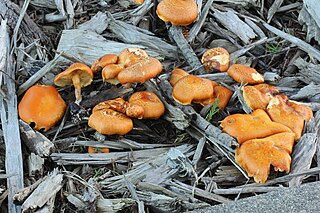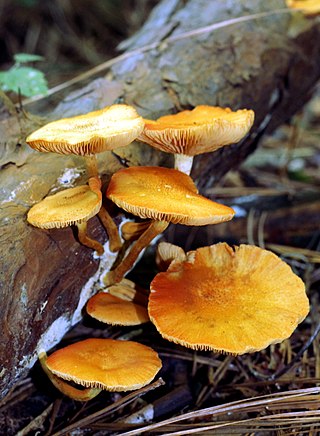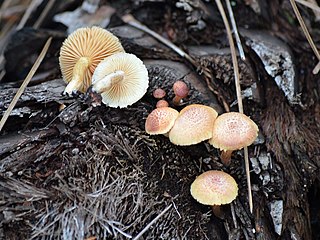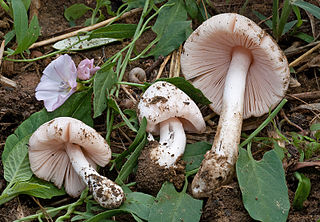
Gymnopilus is a genus of gilled mushrooms within the fungal family Hymenogastraceae containing over 200 rusty-orange spored mushroom species formerly divided among Pholiota and the defunct genus Flammula. The fruit body is typically reddish brown to rusty orange to yellow, medium to large, often with a well-developed veil. Most members of Gymnopilus grow on wood but at times may appear terrestrial if the wood is buried or decomposed. Members of Pholiota and Cortinarius are easy to confuse with Gymnopilus. Pholiota can be distinguished by its viscid cap and duller spores, and Cortinarius grows on the ground. Beginners can confuse Gymnopilus with Galerina, which contains deadly poisonous species.

Gymnopilus sapineus, commonly known as the scaly rustgill or common and boring gymnopilus, is a small and widely distributed mushroom which grows in dense clusters on dead conifer wood. It has a rusty orange spore print and a bitter taste. This species does not stain blue and lacks the hallucinogen psilocybin.

Gymnopilus viridans is a mushroom in the family Hymenogastraceae. It contains the hallucinogens psilocybin and psilocin. It is a rarely documented species, the last known collection being from the US state of Washington in 1912.
Gymnopilus abramsii is a species of mushroom-forming fungus in the family Hymenogastraceae. It was first described by American mycologist Murrill in 1917. The epithet abramsii commemorates LeRoy Abrams.
Gymnopilus aureobrunneus is a species of mushroom in the family Hymenogastraceae.

Gymnopilus bellulus is a species of mushroom in the family Hymenogastraceae. It was given its current name by American mycologist Murrill in 1917. It is odorless, bitter in taste, and regarded as inedible.

Gymnopilus chrysopellus is a species of mushroom in the family Hymenogastraceae.
Gymnopilus chrysotrichoides is a species of mushroom in the family Hymenogastraceae.
Gymnopilus edulis is a species of mushroom in the family Hymenogastraceae. It was given its current name by American mycologist Murrill in 1917.

Gymnopilus echinulisporus is a species of agaric fungus in the family Hymenogastraceae. It was first formally described by American mycologist William Alphonso Murrill in 1912.
Gymnopilus hispidellus is a species of mushroom in the family Hymenogastraceae.

Gymnopilus magnus is a species of mushroom in the family Hymenogastraceae. It was given its current name by American mycologist Murrill in 1917.
Gymnopilus velatus is a species of mushroom in the family Hymenogastraceae. It was given its current name by American mycologist Murrill in 1917.

Gymnopilus underwoodii is a species of agaric fungus in the family Hymenogastraceae. Originally described in 1896 by Charles Peck as Flammula underwoodii, the fungus was given its current name by William Murrill in 1917. The specific epithet honors American mycologist Lucien Underwood.
Gymnopilus pulchrifolius is a species of mushroom in the family Hymenogastraceae. It was given its current name by American mycologist Murrill in 1917.
Gymnopilus pholiotoides is a species of mushroom in the family Hymenogastraceae.

Gymnopilus palmicola is a species of mushroom in the family Hymenogastraceae.

Volvopluteus earlei is a species of mushroom in the family Pluteaceae. It was originally described in 1911 by American mycologist William Alphonso Murrill as Volvariopsis earlei, based on collections made in a Cuban banana field. The fungus was later shuffled to the genera Volvaria and Volvariella before molecular studies placed it in Volvopluteus, a genus newly described in 2011.









